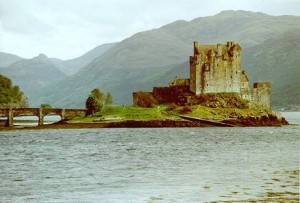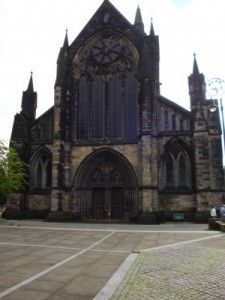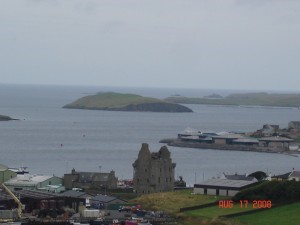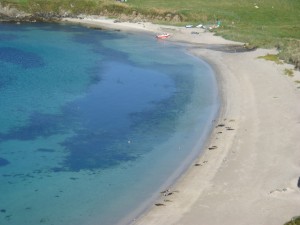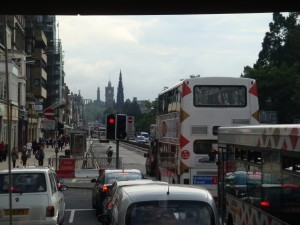The Scotland Chronicles
Scotland captured my heart long ago. And in just 13 days I’ll be heading to that magical place to research my next Scottish series involving the Scottish Templars. I’ll be gone for close to three weeks, starting my journey in Glasgow before heading north to journey into the Highlands. Some of the highlights I’ll be seeing include: Loch Lomond, Inverary Castle, the Isle of Mull, the ruins of Inverlochy Castle, the Isle of Skye, the Orkney and Shetland Islands, Balmoral Castle apartments, St. Andrews, Edinburgh Castle, Roslyn Chapel, and so much more!
Have you ever wanted to head to Scotland? Who wouldn’t enjoy seeing the land of Braveheart, Rob Roy, Robert the Bruce? If so, then come along with me. Starting August 8th, I’ll be blogging about what I see from a writer’s perspective as I journey through Scotland. So, eighteen days in bonny Scotland. You’ll join me, aye?
My heart beats a little faster just thinking about it.
So don’t worry about the driving, the cuisine, or even the weather. Just pull up a chair and come along with me. Barring International broadband complications, I will be posting daily. So check in often and enjoy the trip.
Tabloids, Tiny Cars and Men in Kilts 8-8-08
I think Star Trek had the right idea when they created the teleporter. You can go anywhere you want to instantaneously. Of course, I had this thought after sitting on planes and in taxis for almost a whole day. But I am finally here–in Scotland!
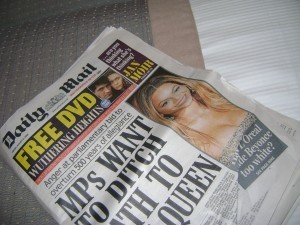 Glasgow is beautiful. I walked around the shopping district this evening to keep myself awake until bedtime in the hopes that I can sleep a full night and wake up in the right time zone. I will post pictures from the streets of Glasgow tomorrow. But for today, a few things hit me as I entered the United Kingdom . . . The tabloids are everywhere. And everyone reads them. No New York Times or Seattle Post Intelligencer here. Of every ten people at the airport and even on the streets, six of them had in their hands the Daily Mail. Interesting.
Glasgow is beautiful. I walked around the shopping district this evening to keep myself awake until bedtime in the hopes that I can sleep a full night and wake up in the right time zone. I will post pictures from the streets of Glasgow tomorrow. But for today, a few things hit me as I entered the United Kingdom . . . The tabloids are everywhere. And everyone reads them. No New York Times or Seattle Post Intelligencer here. Of every ten people at the airport and even on the streets, six of them had in their hands the Daily Mail. Interesting.
Driving in the UK is interesting as well. The cars are tiny, and they drive on the wrong side of the street! It really takes a lot of mental energy to keep your thoughts focused on which side of the road to stay on. The round-abouts are confusing enough, but with jet-lag on top of it all, it was more than my mind could handle tonight. Best leave the driving to the professionals.
Everyone I have met in Scotland so far has been extraordinarily nice. They chat you up about the city, the scenery, and the food. That is if you can understand them. A few times today I had to really listen to what these friendly folks were saying . . . realizing they were speaking English, but not understanding a thing. It’s only going to get worse, I fear, the higher I go into the Highlands. However, I bet with some sleep, things will improve.
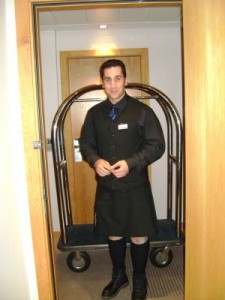 And finally, I realized this evening as I arrived at the hotel and was greeted by a friendly doorman wearing a kilt (and who kindly posed for a picture by a crazy American) that I felt comfortable here. It might be 2008, but I surrounded by pieces of history, some from the very time period in which I write. I part of my heart has always been here in Scotland, and now I know why. It feels like home.
And finally, I realized this evening as I arrived at the hotel and was greeted by a friendly doorman wearing a kilt (and who kindly posed for a picture by a crazy American) that I felt comfortable here. It might be 2008, but I surrounded by pieces of history, some from the very time period in which I write. I part of my heart has always been here in Scotland, and now I know why. It feels like home.
Sleep well all. More tomorrow.
If I could describe Glasgow in one word it would be “eclectic”. The city is an amazing combination of old and new in architecture and people. You can walk down a street and see a building that dates from the medieval times with its aging stone and carved edifice right next to an ultra-modern, sleek, glass building. And right in front of that building you might see an older couple in Scottish woolens standing next to a young couple in fitted jeans with spiked hair chatting to each other.
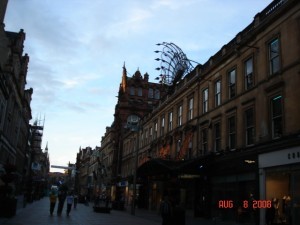 I shopped today in Merchant City. Each section of Glasgow is divided with archways that herald what part of the city you are now entering. Merchant City is lined with shops, pubs, open-air stalls, and little cafes that evoke an old world charm.
I shopped today in Merchant City. Each section of Glasgow is divided with archways that herald what part of the city you are now entering. Merchant City is lined with shops, pubs, open-air stalls, and little cafes that evoke an old world charm.
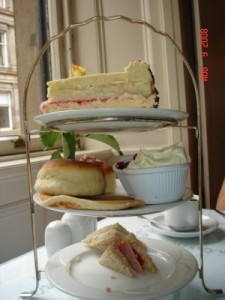 And finally, I found a city, maybe even a whole country, that enjoys tea as much as I do. Tearooms are everywhere. Afternoon tea was breakfast and lunch today. As for calories? Let’s not go there. I am sure the cake alone was more than my daily allotment. But then again, it was so huge I couldn’t finish it.
And finally, I found a city, maybe even a whole country, that enjoys tea as much as I do. Tearooms are everywhere. Afternoon tea was breakfast and lunch today. As for calories? Let’s not go there. I am sure the cake alone was more than my daily allotment. But then again, it was so huge I couldn’t finish it.
Tomorrow it is on to the Cathedral District before heading north. Until then…
Today started with a final look around Glasgow in the Cathedral District. St. Mungo’s Cathedral was originally built in 1136. But over the years it has been added on to in the years since to form what you see today. The grounds are dotted with many crypts and tombstones that look a bit like a competition between the Scots to see who can die and leave the biggest and best monument to themselves behind for posterity.
 Then it was off for Loch Lomand. Only 45 minutes from Glasgow, and you feel as though you’ve entered another world. The loch was calm today for the boat ride from one side of the 23-mile loch to the other. The sky was dark and threatening at times, but the rain waited until later.
Then it was off for Loch Lomand. Only 45 minutes from Glasgow, and you feel as though you’ve entered another world. The loch was calm today for the boat ride from one side of the 23-mile loch to the other. The sky was dark and threatening at times, but the rain waited until later.
 Heading north, the next stop today was Inverary Castle. It’s a beautiful castle/estate to the Argyll family, the senior branch of the Campbell clan. The rooms were elaborately decorated from styles dating from the 15th – 18th centuries. Of course, my favorite room was the armory. The room is covered from eye level to three stories above with pikes, rifles, swords and daggers, both real and ceremonial.
Heading north, the next stop today was Inverary Castle. It’s a beautiful castle/estate to the Argyll family, the senior branch of the Campbell clan. The rooms were elaborately decorated from styles dating from the 15th – 18th centuries. Of course, my favorite room was the armory. The room is covered from eye level to three stories above with pikes, rifles, swords and daggers, both real and ceremonial.
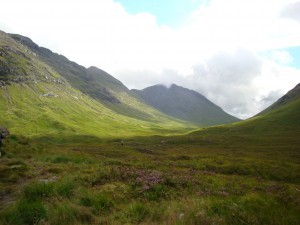 After a quick spot of tea for lunch, it was off to Glencoe. I have seen pictures of Glencoe for years. But nothing — nothing — prepares you for the true beauty when you see it with your own eyes. Breathtaking beauty everywhere you look. As you round each bend you think it couldn’t get lovelier, then it does. Mile after mile of rolling hills and craggy mountains, fields of heather wrapping you in a scent as you gaze upon tumbling waterfalls. The spectacular beauty is so raw and lush it brings tears to the eyes.
After a quick spot of tea for lunch, it was off to Glencoe. I have seen pictures of Glencoe for years. But nothing — nothing — prepares you for the true beauty when you see it with your own eyes. Breathtaking beauty everywhere you look. As you round each bend you think it couldn’t get lovelier, then it does. Mile after mile of rolling hills and craggy mountains, fields of heather wrapping you in a scent as you gaze upon tumbling waterfalls. The spectacular beauty is so raw and lush it brings tears to the eyes.
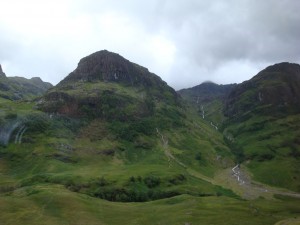 After a tiring day of hiking around in these beautiful hills, I find myself in the quaint seaside town of Oban where I’ll catch the morning ferry to the Isles of Mull and Iona. Looking forward to sharing the sights with you.
After a tiring day of hiking around in these beautiful hills, I find myself in the quaint seaside town of Oban where I’ll catch the morning ferry to the Isles of Mull and Iona. Looking forward to sharing the sights with you.
 Scottish Weather, Black-faced Sheep and the Hebrides 8-11-08
Scottish Weather, Black-faced Sheep and the Hebrides 8-11-08
I decided today that if you don’t like the weather in Scotland, all you have to do is wait ten minutes. Lots of rainsqualls today, wind, sun, more rain. It made for some very atmospheric pictures. Started the day off catching the early ferry from Oban on the Scottish mainland to Craignure on the Isle of Mull. After that, it was a one-hour drive down a single lane road with two-way traffic. There are lots of turnouts, but you don’t always know who is going to turn out, so it gets a bit nerve wrecking at times.
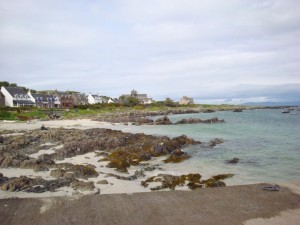 The isle itself is quite beautiful. Formed by ancient volcanoes, you can see lots of interesting formations in the cliffs and craggy hillsides. Covering the isle are miles and miles of moors that are dotted with sheep and red, shaggy cattle the locals call Hairy Coos (or hairy cows). They are beautiful and quite friendly I was told. Though I don’t think I’ll get close enough to check that theory out.
The isle itself is quite beautiful. Formed by ancient volcanoes, you can see lots of interesting formations in the cliffs and craggy hillsides. Covering the isle are miles and miles of moors that are dotted with sheep and red, shaggy cattle the locals call Hairy Coos (or hairy cows). They are beautiful and quite friendly I was told. Though I don’t think I’ll get close enough to check that theory out.
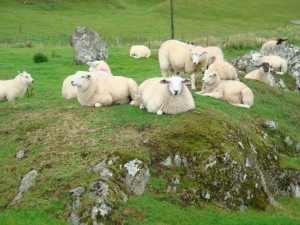 And if you think driving down one-lane roads isn’t bad enough, try doing it with sheep scattered helter-skelter all over the roadside and in the road. Made for an interesting journey. But the trip to Fionnport on the other side of the isle was where you have to catch the next ferry for Iona.
And if you think driving down one-lane roads isn’t bad enough, try doing it with sheep scattered helter-skelter all over the roadside and in the road. Made for an interesting journey. But the trip to Fionnport on the other side of the isle was where you have to catch the next ferry for Iona.
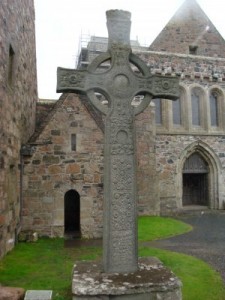 Iona is referred to as the cradle of Christianity in Scotland. It was here that St. Columba first arrived after being banished from Ireland in 563 AD and set up a monastic order. The monastery is still in use today. It was a day well spent wandering though the remains of the old abbey as well as the monastery. Then it was back to the ferry, back on the road, and back to the other ferry to get back to the mainland. Lots of traveling today.
Iona is referred to as the cradle of Christianity in Scotland. It was here that St. Columba first arrived after being banished from Ireland in 563 AD and set up a monastic order. The monastery is still in use today. It was a day well spent wandering though the remains of the old abbey as well as the monastery. Then it was back to the ferry, back on the road, and back to the other ferry to get back to the mainland. Lots of traveling today.
A quick stop in the seaside town of Tobermory finished up the day. Tobermory was a colorful seaside village (the largest on Mull) with one street of shops along the harbor and a distillery set against the hillside. A proper Scottish town I am told is one that has a distillery in it. But I have yet to try a wee dram for myself. I’d say I am more of inclined to shortbread than whiskey.
Just in case I haven’t had enough Scottish narrow-road driving, there will be more of the same tomorrow on the journey to the Isle of Skye. Wish me luck!
The Hogwarts Express, High Peaks, Whiskey, and Glenfinnan 8-13-08
What do these three things have in common? Well nothing actually except that they are the sights I saw today. The day started off with a tour of the Ben Nevis Distillery where I learned how whiskey was made. Not being a whiskey drinker, I had no idea what a huge export it is for Scotland. But I now know the difference between a single malt and a blended whiskey. A high peat and a low peat roasted barley. And that whiskey in Gaelic means “the water of life”. Gosh, and here I was thinking “water” was the water of life. You learn something new every day.
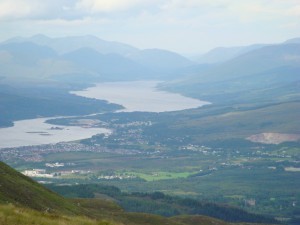 After the tour, I headed down the way for a ride up a cable car to Great Britain’s highest peak; Ben Nevis that rises to an impressive 4,410 feet. At the top, you can see miles of breathtaking scenery. The steep-side valleys here with their thundering waterfalls also served as a backdrop to the movies Highlander, Rob Roy and Braveheart.
After the tour, I headed down the way for a ride up a cable car to Great Britain’s highest peak; Ben Nevis that rises to an impressive 4,410 feet. At the top, you can see miles of breathtaking scenery. The steep-side valleys here with their thundering waterfalls also served as a backdrop to the movies Highlander, Rob Roy and Braveheart.
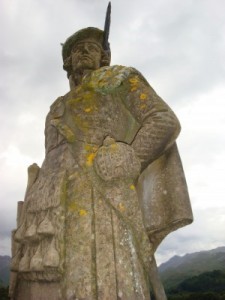 For me, a trip to Scotland would not be complete without a stop at Glenfinnan., a little village steeped in Jacobite history. It was here that Bonnie Prince Charlie raised the Royal Standard and rallied the Highland clans to support his cause to regain the British throne. The site is commemorated by a column topped with a statue of a kilted highlander. I had to climb a very narrow, winding stone staircase in order to take a close up picture of the Highlander at the top.
For me, a trip to Scotland would not be complete without a stop at Glenfinnan., a little village steeped in Jacobite history. It was here that Bonnie Prince Charlie raised the Royal Standard and rallied the Highland clans to support his cause to regain the British throne. The site is commemorated by a column topped with a statue of a kilted highlander. I had to climb a very narrow, winding stone staircase in order to take a close up picture of the Highlander at the top.
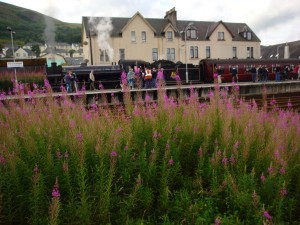 Then, on the opposite side of the visitor’s center was another more modern tourist attraction; the Jacobite Steam train viaduct used in the Harry Potter films. I even caught a sight of the Jacobite Express (otherwise known as the Hogwarts Express) coming down the track.
Then, on the opposite side of the visitor’s center was another more modern tourist attraction; the Jacobite Steam train viaduct used in the Harry Potter films. I even caught a sight of the Jacobite Express (otherwise known as the Hogwarts Express) coming down the track.
Scotland’s Best Kept Secret 8-13-08
Midges? Ever heard of them? I hadn’t until this morning when I felt tiny little stings all over my skin as I walked up and down the waterfront in the tiny town of Kyleakin. I looked at my arms to see tiny, almost little black spots on my arms. Imagine something one-third the size of a gnat that bites like a mosquito. That’s a midge. Thank goodness they don’t like the sun or airflow, because as soon as the sun rose higher in the sky, they disappeared. I’ll be on the lookout tomorrow, and wearing long sleeves!
Today was filled with a guided tour of the Isle of Skye. The isle is approximately 80 miles long with many different peninsulas, each with their own unique features. The mighty Red Cuillins and Black Cuillins, formed by volcanoes many years ago thrust high overhead at 3,000 feet. They are just some of the 22 peaks that dot the isle.
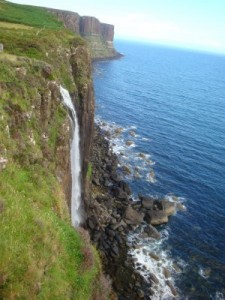 On another peninsula I saw spectacular cliffs that dropped into the sea. And learned that dinosaurs once walked the earth here.
On another peninsula I saw spectacular cliffs that dropped into the sea. And learned that dinosaurs once walked the earth here.
The guide shared all kinds of colorful history about the MacDonald, MacCleod, and MacKinnon clans, as well as the Fraisers and the MacQueens; all clans that occupied the Isle of Skye. The Scottish people love to tell tales. Most are steeped in truth, with a touch of embellishment for color.
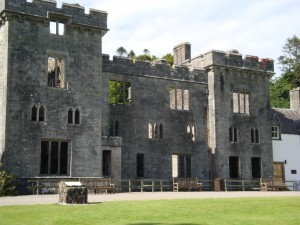 When the tour ended, I found myself at Armadale castle, strolling among the ruins and soaking in the history at the Clan Donald center. Nothing makes me happier than sitting in the ruins of an old castle, thinking about the people who once lived there.
When the tour ended, I found myself at Armadale castle, strolling among the ruins and soaking in the history at the Clan Donald center. Nothing makes me happier than sitting in the ruins of an old castle, thinking about the people who once lived there.
Tomorrow, it’s off to Ullapool, even higher into the Highland hills. Until then…
 Two Castles, a Monster, and a Bloody Battle 8-14-08
Two Castles, a Monster, and a Bloody Battle 8-14-08
There are so many castles to see in Scotland, each with their own personality. I got to see two such castles today. Eilean Donan started the day. This castle started out as a Pictish fort, but over the years has evolved into mighty fortress that guards two lochs. Destroyed by the Government during a Jacobite uprising, the castle has now been restored to its former thirteenth-century glory.
 Another castle further north was not rebuilt. Urquart Castle stands along the shores of Loch Ness, a shell of its former glory.
Another castle further north was not rebuilt. Urquart Castle stands along the shores of Loch Ness, a shell of its former glory.
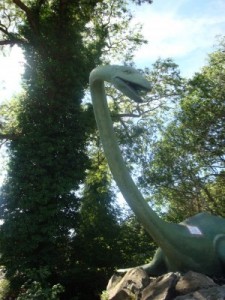 Along the banks of Loch Ness I looked and looked, but did not sight the famous monster, Nessie. I was impressed, however, with how effectively the Scottish government has capitalized on this myth to turn Loch Ness into a major tourist attraction. In the gift store you could pick up just about anything imaginable with a Nessie motif: Nessie clothes, Nessie china, Nessie chocolate, stuffed Nessies, Nessie jewelry, ceramic Nessies. I even saw a Nessie wall clock.
Along the banks of Loch Ness I looked and looked, but did not sight the famous monster, Nessie. I was impressed, however, with how effectively the Scottish government has capitalized on this myth to turn Loch Ness into a major tourist attraction. In the gift store you could pick up just about anything imaginable with a Nessie motif: Nessie clothes, Nessie china, Nessie chocolate, stuffed Nessies, Nessie jewelry, ceramic Nessies. I even saw a Nessie wall clock.
The afternoon took a more somber tone when I arrived at the Battlefield of Colloden where 6,000 Scotsmen made their last stand of Scottish independence. The battlefield is well preserved by the National Trust. A brand new visitor’s center does an excellent job at presenting both the Government and Jacobite sides of the battle, a battle that left over 1,200 Scotsmen dead in less than fifty minutes. The best and worst part of the exhibit was a surround theater that showed on screens all around you. Standing in the center the entire battle went on around you. Very bloody, and when it ended it was a little hard to breathe, so intense was the emotion.
Tomorrow, it’s off to the northernmost coast of the British Isles—John O’Groates. Internet access is getting spotty, but I’ll report in when I can. I learned today that much of the Highlands did not get electricity into their homes until the 1960s. Some areas of Scotland are very remote.
Driving to the End of the Earth 8-17-08
I left the northwest coast of Scotland today to head for the northeastern side. The drive was long but scenic. Lots of mountains, or Bens as they call them here–peaks over 3,000 feet. Each area of Scotland I have been through has been so different, even though there are moors and mountains in each; they all have their own uniqueness. Up in the northern Highlands, rocky deposits left by the glaciers cover the land. In the valleys, you find peat bogs, the remnants of lochs that have dried up, leaving partially decayed plants behind. The Highlanders still use peat as an energy source today. When burned, it has a sweet, smoky scent.
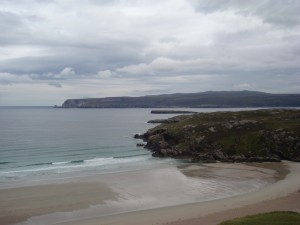 As you approach the furthermost northern coastline, a surprise awaits: beautiful sandy beaches. If it were a bit warmer here, they would rival the beaches in Hawaii. I’m told that on a sunny day, the water is tolerable for a “wee dip”. Don’t think I’ll be trying that anytime soon.
As you approach the furthermost northern coastline, a surprise awaits: beautiful sandy beaches. If it were a bit warmer here, they would rival the beaches in Hawaii. I’m told that on a sunny day, the water is tolerable for a “wee dip”. Don’t think I’ll be trying that anytime soon.
Stopped in several of the roadside towns today and an interesting thing hit me. All along the roads I’ve been noticing old war bunkers, listening posts, and hearing tales of sunken ships and submarines in the sea lochs. So many of these little out-of-the-way places you also find war memorials to honor those Scotsmen who served in WWI with fresh wreathes placed at the base. It surprised me to see how involved Scotland was in the war, and how much history of that time still remains just as it was—a lasting footprint.
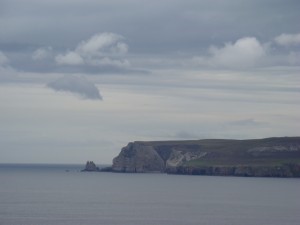 Headed for one of the northernmost tips of Scotland in the afternoon: John O’Groates. Named after a man named John, who used to charge four groates to take people from the edge of Scotland out to the Orkney Islands in his boat. A ferry service still exists in the area, but it costs a lot more than four groates to go to the Orkney’s. It was kind of amazing being at the edge of Scotland today. The cliffs fall away into the sea, and if you didn’t know the Orkney Islands were there, it would be easy enough to assume you had reached the edge of the earth.
Headed for one of the northernmost tips of Scotland in the afternoon: John O’Groates. Named after a man named John, who used to charge four groates to take people from the edge of Scotland out to the Orkney Islands in his boat. A ferry service still exists in the area, but it costs a lot more than four groates to go to the Orkney’s. It was kind of amazing being at the edge of Scotland today. The cliffs fall away into the sea, and if you didn’t know the Orkney Islands were there, it would be easy enough to assume you had reached the edge of the earth.
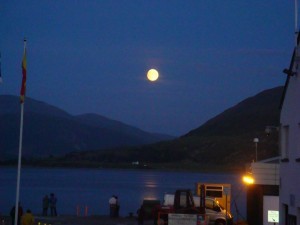 I saw my first Scottish Harvest moon today. Beautiful.
I saw my first Scottish Harvest moon today. Beautiful.
It’s off to the Orkney Islands, then on to the Shetland Islands tomorrow. It involves an overnight ferry. This could get interesting.
Until then…
 The Queen Mother’s Castle and Ancient Civilizations 8-17-08
The Queen Mother’s Castle and Ancient Civilizations 8-17-08
The day started with a morning visit to the Queen Mother’s castle, the Castle of Mey. Both the castle and the gardens were lovely. The interior of the castle was more austere than I expected from a royal residence. But this is the Queen Mother’s own castle, not Britain’s. I was a little strange to walk throughout and see pictures of the Princes Charles, Andrew, and Edward, as well as Princess Margaret. Yet again, they are her grandchildren.
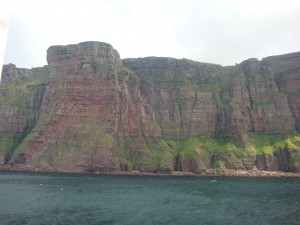 Caught a ferry for the Orkney Islands and said goodbye to the Scottish mainland. Cruising along the coastline was breathtaking. The sea cliffs are a sight to behold. The ferry went right past the Old Man of Hoy, and the Lifeboat (British Isles water rescue patrol) flew past the ferry a few times in training maneuvers.
Caught a ferry for the Orkney Islands and said goodbye to the Scottish mainland. Cruising along the coastline was breathtaking. The sea cliffs are a sight to behold. The ferry went right past the Old Man of Hoy, and the Lifeboat (British Isles water rescue patrol) flew past the ferry a few times in training maneuvers.
 The Orkney Islands themselves were far more populated than I had expected. I’ve seen so few people in the Highlands lately that the town of Stromness where the ferry docked seemed like a metropolis by comparison. From the ferry, I headed for the Neolithic settlement of Skara Brae. Fascinating. If this place were closer to the mainland, it would be as huge an attraction as Stonehenge. It was well worth the effort to get here. Skara Brea was discovered in the 1950s after a hurricane force storm blew through the Orkney’s uncovering the remains of a 5,000-year-old civilization. The settlement remains well-preserved and has answered many questions about Neolithic man and how they lived.
The Orkney Islands themselves were far more populated than I had expected. I’ve seen so few people in the Highlands lately that the town of Stromness where the ferry docked seemed like a metropolis by comparison. From the ferry, I headed for the Neolithic settlement of Skara Brae. Fascinating. If this place were closer to the mainland, it would be as huge an attraction as Stonehenge. It was well worth the effort to get here. Skara Brea was discovered in the 1950s after a hurricane force storm blew through the Orkney’s uncovering the remains of a 5,000-year-old civilization. The settlement remains well-preserved and has answered many questions about Neolithic man and how they lived.
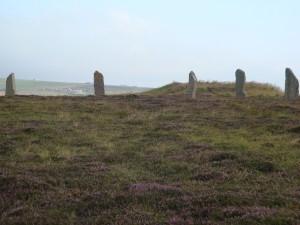 Two Neolithic stone circles filled the late afternoon: the ring of Brodger and the Stenness Stone Circles. I walked the ring of both of these circles. Because they are so far off the beaten tourist track, you can still do that. I felt a very real sense of peace walking around them.
Two Neolithic stone circles filled the late afternoon: the ring of Brodger and the Stenness Stone Circles. I walked the ring of both of these circles. Because they are so far off the beaten tourist track, you can still do that. I felt a very real sense of peace walking around them.
Now, I’m sitting in the Hjaltland, and overnight ferry, on a tiny bed in a sleeper cabin that will take me to the Shetland Islands. It will be kind of nice to wake up and be at the next destination. I’ll fill you in on more tomorrow.
This morning the ship pulled into port in the town of Lerwick where I met a guide who will be a guide to Shetland for the next two days. We explored the northern side of the island today, starting with Scalloway Castle at Scalloway Harbor. I learned that Shetland, as the locals like it to be called, is made up of a chain of 100 islands that span 90 miles. Shetland lays 300 miles from Norway and 300 miles from Aberdeen, Scotland. Yet these isles have a more Scandinavian feel to them than a Scottish feel. The isles of Orkney and Shetland were once part of Norway, but were given to Scotland when Margaret of Norway married James III of Scotland. Her father, Christian I, had no dowry money to offer, so he pawned the isles to Scotland instead. Twice Norway has tried to buy the isles back without success.
Lots of Viking influence on the isles. Burial sites, history, and a past that is well reflected in the art and culture in the small towns. Shetland is not as densely populated as Orkney. Only 22,000 live on the isles. Yet there are close to 300,000 sheep that live here, as well as 1,000 Shetland ponies.
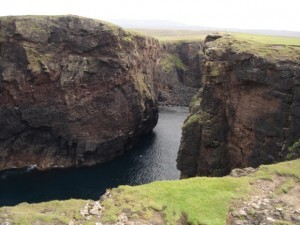 The most exciting thing we did today was drive to the cliffs at Hermaness, where the Puffins nest. The scenery was dramatic. We missed the Puffins by one week. They leave the area for warmer climate August 1 – 10. The drive was worthwhile anyhow.
The most exciting thing we did today was drive to the cliffs at Hermaness, where the Puffins nest. The scenery was dramatic. We missed the Puffins by one week. They leave the area for warmer climate August 1 – 10. The drive was worthwhile anyhow.
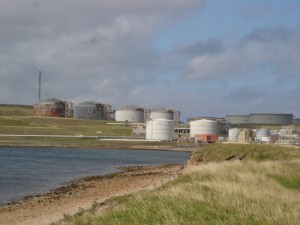 Oil refineries are off the coast of Shetland. We drove past an important oil terminal today that overlooked Yell Sound. The average price for gas in the UK is around one pound sixteen pence per liter. That works out to over ten dollars a gallon. Guess we shouldn’t complain so much in the states. An interesting fact that our guide told us was that the five oil tanks on the hill in this picture only hold enough fuel to service Great Britain for twelve hours. You can fit a jumbo jet inside those tanks.
Oil refineries are off the coast of Shetland. We drove past an important oil terminal today that overlooked Yell Sound. The average price for gas in the UK is around one pound sixteen pence per liter. That works out to over ten dollars a gallon. Guess we shouldn’t complain so much in the states. An interesting fact that our guide told us was that the five oil tanks on the hill in this picture only hold enough fuel to service Great Britain for twelve hours. You can fit a jumbo jet inside those tanks.
It’s off to the other side of Shetland tomorrow.
Exploring the Past 8-19-08
Every country and culture has its own unique history. Shetland is no diffeent, only their history goes back further than most, into pre-history. Today I had a wonderful walk through the past at Jarlshof on the southern tip of Shetland. The first people to arrive here probably came over 5,000 years ago when the climate was warmer and there were landmasses that connected more of the isles and continents.
Jarlshof is a showcase of civilized development as it is revealed through the progression of a settlement that has been dated as far back as 3,500 year ago. There are six definite settlements in the area. One each from the Stone Age, the Bronze Age, the Iron Age, the Pictish era, the Norse era, then the Middle Ages. All within a short walking distance you can span several eras. And because the area is so remote with so few travelers who might damage the settlements, you are allowed to go inside the later settlements.
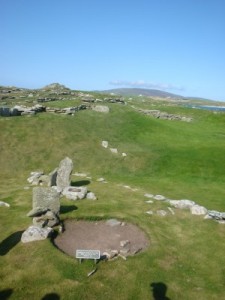 The first settlement was that of a Stone Age home; containing a central fire and a midden (or a rubbish dump) that revealed what people of this time period ate.
The first settlement was that of a Stone Age home; containing a central fire and a midden (or a rubbish dump) that revealed what people of this time period ate.
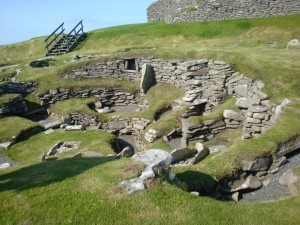 The second settlement was that of a late Bronze Age smithy used some 2,800 years ago.
The second settlement was that of a late Bronze Age smithy used some 2,800 years ago.
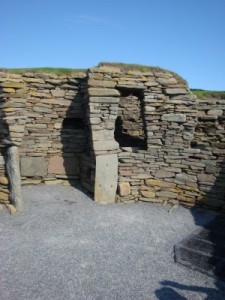 The third settlement is where there was once a large Iron Age roundhouse in the courtyard of a broch built around 2,000 years ago. Several brochs have been discovered across Shetland. They were fourteen feet tall, with three stories. The bottom story was used for the animals, who needed protection from the weather, but who also helped to heat the house. The next two floors were for the human inhabitants.
The third settlement is where there was once a large Iron Age roundhouse in the courtyard of a broch built around 2,000 years ago. Several brochs have been discovered across Shetland. They were fourteen feet tall, with three stories. The bottom story was used for the animals, who needed protection from the weather, but who also helped to heat the house. The next two floors were for the human inhabitants.
 The best-preserved settlement was that of the fourth–a wheelhouse-style broch was occupied by the Pictish people until the Norsemen arrived.
The best-preserved settlement was that of the fourth–a wheelhouse-style broch was occupied by the Pictish people until the Norsemen arrived.
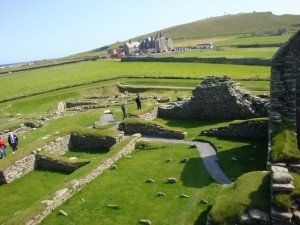 The fifth settlement revealed a Norse house, which may date from the early ninth century.
The fifth settlement revealed a Norse house, which may date from the early ninth century.
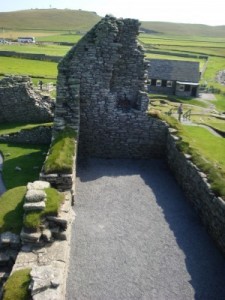 Finally, the last settlement was that of a medieval farmhouse that lay near the laird’s house from the seventeenth century.
Finally, the last settlement was that of a medieval farmhouse that lay near the laird’s house from the seventeenth century.
All in all, it was a fascinating day that also included a bit of wildlife: seabirds and seals.
Tonight, I board an overnight ferry back to Aberdeen. It’s a twelve hours crossing. This time I am armed with seasickness pills, ginger, and seasickness wristbands. I have learned I am not meant to be a seafarer. This girl likes land.
Until tomorrow…
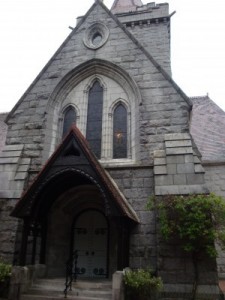 When the Queen is in residence . . . 8-19-08
When the Queen is in residence . . . 8-19-08
Balmoral Castle was off limits today. The Queen is in residence. So I got diverted to the very scenic Cairngorms National Park, then poked around the quaint little town of Ballater where the Royals are said to shop when in the area. After that, it was off to Crathie Church where the Royals attend services when at Balmoral. The Royal Family have their own separate entrance to the church.
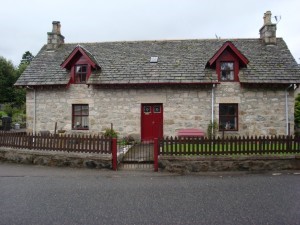 One of the things I have so enjoyed seeing are the Scottish cottage houses that dot the countryside. Here is an example of a typical Scottish cottage.
One of the things I have so enjoyed seeing are the Scottish cottage houses that dot the countryside. Here is an example of a typical Scottish cottage.
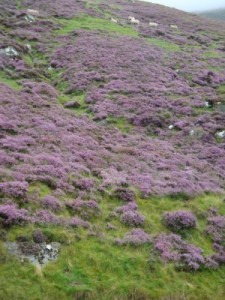 The drive through the Cairngorms was spectacular. During August the heather blooms and the hillsides were covered in a deep purple blanket. The scent is amazing. I will never look at heather again without thinking about Scotland.
The drive through the Cairngorms was spectacular. During August the heather blooms and the hillsides were covered in a deep purple blanket. The scent is amazing. I will never look at heather again without thinking about Scotland.
The day ended very pleasantly with a trip to Glamis Castle, the seat of the Earls of Strathmore and Kinghorn and the one-time home of Lady Elizabeth who went on to become the Queen Mother.
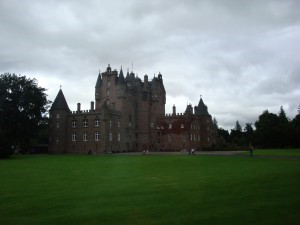 Glamis Castle is a conglomeration of fourteenth, sixteenth, and eighteenth century architecture. The result is a castle that resembles in many ways Cinderella’s Castle at Disneyland. Glamis Castle provided the setting for the murder of Duncan in Shakespeare’s Macbeth. The castle is also said to have more ghosts than any other castle in Scotland. One of those ghosts is said to be Lady Janet Glamis who was burnt as the stake as a witch by James V.
Glamis Castle is a conglomeration of fourteenth, sixteenth, and eighteenth century architecture. The result is a castle that resembles in many ways Cinderella’s Castle at Disneyland. Glamis Castle provided the setting for the murder of Duncan in Shakespeare’s Macbeth. The castle is also said to have more ghosts than any other castle in Scotland. One of those ghosts is said to be Lady Janet Glamis who was burnt as the stake as a witch by James V.
The evening found me heading southeast to the village of Montrose. Tomorrow, I head for Edinburgh and will attend the famous Military Tattoo. I am hoping the rain lets up. These things are never cancelled due to weather.
Wish me luck!
Heading to Edinburgh 8-22-08
I headed back to a much more populated part of Scotland today. Started the day off with a trip through Dundee—a city known historically for its jam, jute and journalism. Today, the only industry that survives is journalism. Dundee is the home of the Sunday Post.
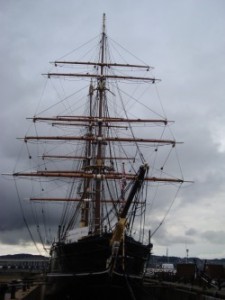 Dundee also had a past as a whaling center, but that declined when the whale population dwindled. Yet that very industry is what set up Dundee as the premier location for the first scientific exploration in 1901 to the Antarctic. Captain Robert Scott led the first voyage on the Discovery.
Dundee also had a past as a whaling center, but that declined when the whale population dwindled. Yet that very industry is what set up Dundee as the premier location for the first scientific exploration in 1901 to the Antarctic. Captain Robert Scott led the first voyage on the Discovery.
Did you know Scotland has more golf courses than any country in the world? Did you know they were the creators of the game? I was told today as I visited both the Carnoustie and St. Andrews Golf Courses that the Scottish people originally called the game that you played with a small leather ball flog. But decided to change the name when the associate to flogging developed. They reversed the letters and came up with the word golf. Don’t know if that’s a true story, or a Scottish tale. You decide.
 In the area of St. Andrews golf course is also St. Andrews University. The university was one of the first universities in Scotland, and one of the first in the world to allow women to attend. They could not get a degree, but they could be educated. In recent history, the university is also the one Prince William chose to attend.
In the area of St. Andrews golf course is also St. Andrews University. The university was one of the first universities in Scotland, and one of the first in the world to allow women to attend. They could not get a degree, but they could be educated. In recent history, the university is also the one Prince William chose to attend.
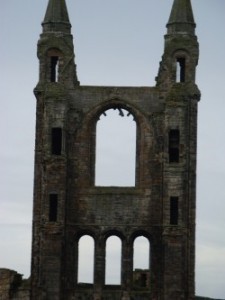 The highlight of the day so far would have to be St. Andrews Cathedral. In medieval times, St. Andrews was the premier cathedral city and place of pilgrimage. The area has been a monastic center since 747 AD. Over the years the community developed until St. Andrews became an important center of religious life in eighth century. The cathedral reached its preeminence when its bishop became Scotland’s first archbishop in 1472. However, it did not survive the Reformation of the Scottish Church in 1560. The ruins are still beautiful to wander through, as do the many ornate gravestones that lay within the grounds.
The highlight of the day so far would have to be St. Andrews Cathedral. In medieval times, St. Andrews was the premier cathedral city and place of pilgrimage. The area has been a monastic center since 747 AD. Over the years the community developed until St. Andrews became an important center of religious life in eighth century. The cathedral reached its preeminence when its bishop became Scotland’s first archbishop in 1472. However, it did not survive the Reformation of the Scottish Church in 1560. The ruins are still beautiful to wander through, as do the many ornate gravestones that lay within the grounds.
Tonight, I will attend the Military Tattoo. The rain has stopped, but the clouds remain. It doesn’t matter though. I’m a Seattleite in Scotland. A little rain won’t hurt me.
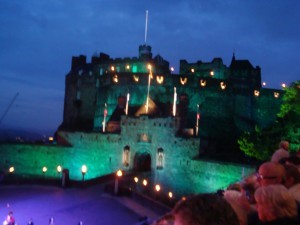 The Edinburgh Military Tattoo 8-22-08
The Edinburgh Military Tattoo 8-22-08
The tickets are almost impossible to get. They play to a sold out crowd every performance. Who or what am I referring to? No, it is not the latest pop singing group. It’s the Edinburgh Military Tattoo.
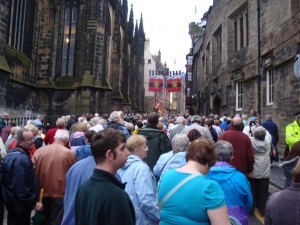 As you arrive, the streets are a throng of people all heading up the Royal Mile to Castle Hill and Edinburgh Castle.
As you arrive, the streets are a throng of people all heading up the Royal Mile to Castle Hill and Edinburgh Castle.
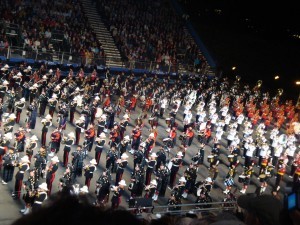 Every year the tattoo has a theme. This year the theme celebrates the centenary of Queen Victoria School at Dunblane. The children from the school participated as did acts from America, Singapore, New Zealand, His Majesty The King’s Guards from Norway, pipes and drums from Australia, as well as a military band from the Indian Army.
Every year the tattoo has a theme. This year the theme celebrates the centenary of Queen Victoria School at Dunblane. The children from the school participated as did acts from America, Singapore, New Zealand, His Majesty The King’s Guards from Norway, pipes and drums from Australia, as well as a military band from the Indian Army.
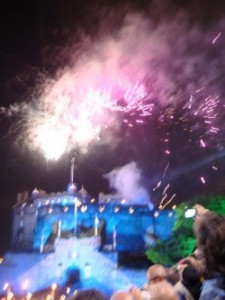 The show was spectacular. Not only were the sounds and performances magical, so were the images displayed directly onto the entrance to Edinburgh Castle. Magical is the only word that truly describes the night. It was an incomparable show of sights and sounds in an incomparable setting.
The show was spectacular. Not only were the sounds and performances magical, so were the images displayed directly onto the entrance to Edinburgh Castle. Magical is the only word that truly describes the night. It was an incomparable show of sights and sounds in an incomparable setting.
 Edinburgh Castle and Roslyn Chapel 8-22-08
Edinburgh Castle and Roslyn Chapel 8-22-08
Edinburgh is a very big city, and very crowded at present. Usually there are half a million people that live in the area. Currently there are over a million people in town. Why? Someone thought it was a great idea to have every festival the city hosts during the month of August. The streets are packed with people attending the International Festival of Music and Drama, The Fringe Festival, the Film Festival, Jazz and Blues Festival, the Book Festival, the Arts and Crafts Festival, and the Military Tattoo, that alone attracts 10,000 people each night. Lots and lots of people.
It is kind of fun though to walk down the streets and everywhere you look there are venues of the Fringe Festival. These are the acts that want to participate in the Festival of Music and Drama but didn’t get into the more traditional venues. Yesterday I got to hear several music acts and witnessed a play being performed in the doorway of a men’s restroom. Unique to say the least.
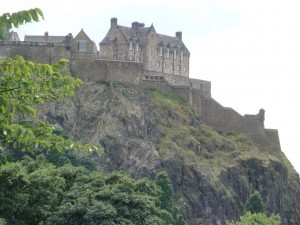 The big highlight of the day was touring Edinburgh Castle. Everywhere you look in the city center, the castle is there, perched atop a rock bluff. You enter through the front gate, cross the stone bridge, then proceed through five gates and an iron portcullis before you reach the lower level of the castle. Very impressive and effective security. And still the castle was taken over at least twice in its history. Another highlight of the castle tour for me was seeing the Honors of Scotland—the crown, the scepter, the sword, and the Stone of Destiny that I featured in my first book, The Warrior Trainer. It looks exactly as I imagined.
The big highlight of the day was touring Edinburgh Castle. Everywhere you look in the city center, the castle is there, perched atop a rock bluff. You enter through the front gate, cross the stone bridge, then proceed through five gates and an iron portcullis before you reach the lower level of the castle. Very impressive and effective security. And still the castle was taken over at least twice in its history. Another highlight of the castle tour for me was seeing the Honors of Scotland—the crown, the scepter, the sword, and the Stone of Destiny that I featured in my first book, The Warrior Trainer. It looks exactly as I imagined.
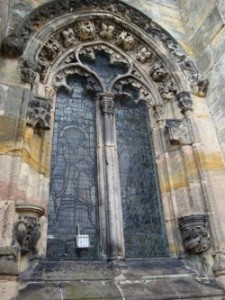 The afternoon found me at Roslyn Chapel. The guide at Roslyn Chapel said two miracles have come to the chapel. The first being that Cromwell did not destroy the place during his campaign through Scotland. He housed his horses in the chapel, destroyed the nearby Roslyn Castle, but left the chapel untouched. The second miracle was Dan Brown’s Da Vinci Code. So many visitor have flooded to the chapel since the launch of the book and the subsequent movie, that much needed funds have come to the chapel that have allowed for massive restoration efforts to preserve what was starting to decay.
The afternoon found me at Roslyn Chapel. The guide at Roslyn Chapel said two miracles have come to the chapel. The first being that Cromwell did not destroy the place during his campaign through Scotland. He housed his horses in the chapel, destroyed the nearby Roslyn Castle, but left the chapel untouched. The second miracle was Dan Brown’s Da Vinci Code. So many visitor have flooded to the chapel since the launch of the book and the subsequent movie, that much needed funds have come to the chapel that have allowed for massive restoration efforts to preserve what was starting to decay.
Tomorrow, I get to stay put in Edinburgh for a while and do some necessary research. Check in with me tomorrow to see where I’ll be.
Some Castles are Truly Palaces 8-22-08
Today it was raining a lot. I even broke down and bought an umbrella. After that, the rain stopped, of course. But it didn’t matter. I’d already decided to spend the day touring inside at the Palace of Holyroodhouse.
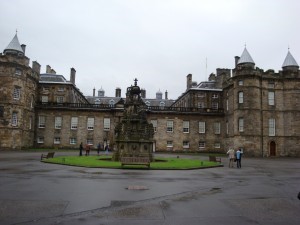 The Palace at Holyroodhouse stands at the end of Edinburgh’s Royal Mile and is the official residence of the Queen when she is in Scotland. The State Apartments are renowned for their magnificent plasterwork ceilings and beautiful tapestries. One of the most impressive rooms in the Palace is the Great Gallery where you find portraits of real and legendary kings of Scotland.
The Palace at Holyroodhouse stands at the end of Edinburgh’s Royal Mile and is the official residence of the Queen when she is in Scotland. The State Apartments are renowned for their magnificent plasterwork ceilings and beautiful tapestries. One of the most impressive rooms in the Palace is the Great Gallery where you find portraits of real and legendary kings of Scotland.
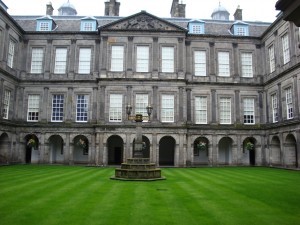 The Palace is probably best known as the home of Mary, Queen of Scots, and was the setting for many dramatic episodes in her short reign. It was here Mary witnessed the brutal murder of her secretary, Rizzo, by her jealous husband.
The Palace is probably best known as the home of Mary, Queen of Scots, and was the setting for many dramatic episodes in her short reign. It was here Mary witnessed the brutal murder of her secretary, Rizzo, by her jealous husband.
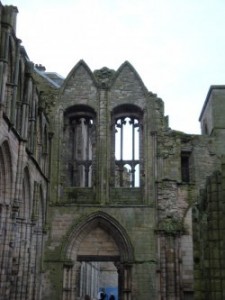 On the grounds of the Palace are the ruins of the 12th-century abbey. According to legend, King David I founded the abbey on the very spot where he had a vision of a stag with a cross between its antlers.
On the grounds of the Palace are the ruins of the 12th-century abbey. According to legend, King David I founded the abbey on the very spot where he had a vision of a stag with a cross between its antlers.
Tomorrow is my final day in Scotland. I’m heading for the Royal Museum and the Museum of Scotland. I’ll report in when I can.
Until then…
My last day in Scotland I spent being a tourist around Edinburgh. I shopped along Princes Street. Bought a kilt for my husband so that when I miss bits of Scotland, I’ll have my own adorable Scotsman at home.
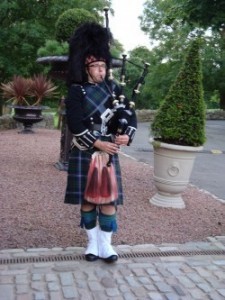 I listened to my last on-the-street bagpipe performance. Let’s face it, pipers are just not too common in Bellevue!
I listened to my last on-the-street bagpipe performance. Let’s face it, pipers are just not too common in Bellevue!
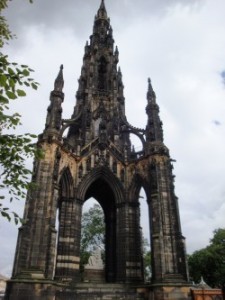 I visited the Sir Walter Scott Monument. You can’t go far in Scotland without seeing some reference to Sir Walter Scott or Robert Burns. Two authors they still love today.
I visited the Sir Walter Scott Monument. You can’t go far in Scotland without seeing some reference to Sir Walter Scott or Robert Burns. Two authors they still love today.
I toured the National Museum of Scotland. This was a wonderful thing to do at the end of my trip because it had little bits and pieces of all the sights I had seen during my journey through the Highlands. It was a wonderful way to synthesize all the information I’d gathered.
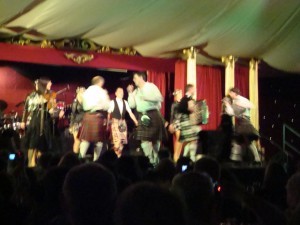 I went to a Scottish dinner show and tried Haggis . . . one small bite. Didn’t taste too bad, but I couldn’t get past what they ground up to put in the stuff (hint for those of you haggis novices, they use all the “other” parts that one normally doesn’t eat of sheep and cows, mix it with oats and spices and boil it in intestine). All that kind of made the whiskey tasting that followed seem like a joy. I even found a Whiskey that I didn’t detest too much.
I went to a Scottish dinner show and tried Haggis . . . one small bite. Didn’t taste too bad, but I couldn’t get past what they ground up to put in the stuff (hint for those of you haggis novices, they use all the “other” parts that one normally doesn’t eat of sheep and cows, mix it with oats and spices and boil it in intestine). All that kind of made the whiskey tasting that followed seem like a joy. I even found a Whiskey that I didn’t detest too much.
I got my last midge bite. I will not miss those little guys at all! And I ate my last scone. I found I preferred the Edinburgh scones with little pieces of fruit in them to the regular. I had to sample my way through Scotland just to confirm that theory. Tough job, but someone had to do it.
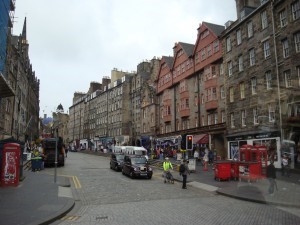 I’ve loved my time here in Scotland. It’s a place that has felt incredibly familiar. A place where I felt very accepted and where I met some very wonderful people. It’s proved to me that we, as a society, have come a long way from those early Neolithic days, but that we have not forgotten what is truly important in life—each other and our shared history.
I’ve loved my time here in Scotland. It’s a place that has felt incredibly familiar. A place where I felt very accepted and where I met some very wonderful people. It’s proved to me that we, as a society, have come a long way from those early Neolithic days, but that we have not forgotten what is truly important in life—each other and our shared history.
From Scotland for the last time,
Cheers, mates!








